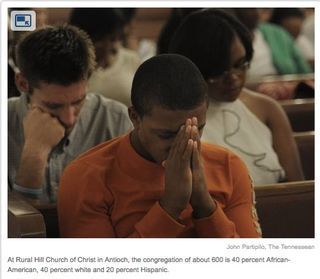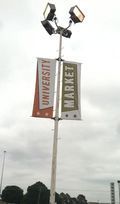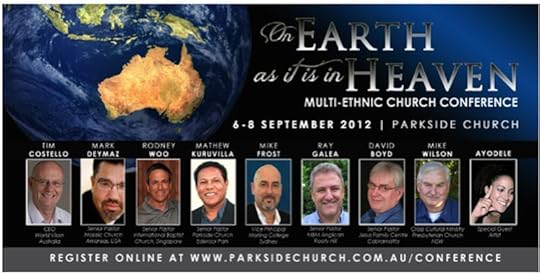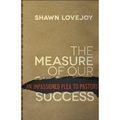Mark DeYmaz's Blog, page 3
January 5, 2013
Who (Really) Is My Neighbor?

November 26, 2012
Let's Make History Again!

October 25, 2012
Real Community Transformation!

October 9, 2012
A Balanced Strategy
In this video, Mark DeYmaz explains explains why a local church should consider a multi-dimensional strategy in pursuit of Real Community Transformation. Specifically, he details a three-dimensional strategy of community engagement whereby the spiritual, social and financial needs of the community are addressed, simultaneously, in order to get beyond rhetoric to results in this regard for the glory of God.
Real Community Transformation-Mark DeYmaz-Three Legged Stool from Mosaic Church on Vimeo.
Become a Benevolent Owner
In this video, Mark DeYmaz explains why a local church should consider becoming a Benevolent Owner in pursuit of Real Community Transformation. In so doing, churches can promote a Win-Win-Win strategy in helping to improve the economic conditions of a community and get beyond rhetoric to results for the glory of God.
Real Community Transformation-Mark DeYmaz-Benevolent Owner from Mosaic Church on Vimeo.
September 18, 2012
Today in USA Today!
 Readers of USA Today awoke this morning to an article by Bob Smietana calling attention to the growing advance of the Multi-ethnic Church Movement! Click here to read the entire article which includes comments from Mosaix Advisory Board Members, Efrem Smith and Soong-Chan Rah.
Readers of USA Today awoke this morning to an article by Bob Smietana calling attention to the growing advance of the Multi-ethnic Church Movement! Click here to read the entire article which includes comments from Mosaix Advisory Board Members, Efrem Smith and Soong-Chan Rah.
As
with all articles, an oppositional quote is also part of the article;
this one, from my good friend, Dr. Gary McIntosh. Here's the excerpt:
Gary
McIntosh, professor of Christian Ministry and Leadership at Biola
University in La Mirada, Calif., doubts that multiethnic churches will
ever become commonplace. He said it's human nature for churches to
attract people who share a common background or culture. That doesn't
mean they are intentionally segregated, McIntosh said. "Churches gather
around to worship Jesus Christ -- but there are always secondary factors
that draw people together," he said.
Hmmm ... let me counter his statement:
1.
Gary is a good man, but unfortunately left alone to defend (perhaps)
unintended, but nevertheless very real consequences of a misunderstanding and misapplication of the Homogeneous Unit Principle (HUP)
promoted through the years by the so-called Church Growth Movement
(which he has helped to perpetuate as a past President of the American Society for Church Growth). For decades this principle has been promoted as the modus operandi for
those who would plant, grow or develop successful churches in the
United States typically measured by numbers, dollars and buildings. But
did you know the principle’s very own progenitor, Donald McGavran,
himself, had this to say about the HUP ... “Do, I beg of you, think of it primarily a missionary and evangelistic principle.” McGavran also warned that with any misunderstanding or misapplication of the HUP, “there is a danger that congregations…become exclusive, arrogant, and racist. That danger must be resolutely combated.”
Ask yourself, Do you know of or suspect any churches today of being so inclined?
For
a complete discussion of this subject, and to learn how the HUP more
accurately and biblically applies to church planting, growth and
development today, download this free eBook resource from Mosaix! (note: after downloading, make sure you check your junk/spam folder if you don't see it right away)
2. Furthermore, while we might all agree with Gary that "it's human nature
for churches to attract people who share a common background or
culture," doesn't the Christian life call us to rise above what is
otherwise natural in order to embrace the supernatural; to operate in
the Spirit and not the flesh? Indeed, isnt it about aligning the church
with Christ's vision and not our own?
3. Finally if churches are
targetting a partiucular demographic, i.e., planting, growing, or
developing focused on a single people group, those with a common
background or culture, etc., how can one argue "they are not
intentionally segrgeated?"
I welcome your comments.
September 5, 2012
Making History in Australia!
G'day Mates ...
At this moment, I'm writing from a hotel in Sydney where it's 1:30 am local time (Thursday, September 6). I'm here representing you and Mosaix in support my good friend, Pastor Mathew Kuruvilla, senior pastor of Parkside Church, who's hosting the first national conference ever held in Australia on the multi-ethnic church. Patterned after Mosaix' first national conference in the United States (San Diego, November 2010), this conference has drawn more than 200 pastors and ministry leaders from Australia, and many of the country's denominations are involved, as well!
In fact, over pizza last night, Mathew shared his excitement at the entusiastic response he's received and remarkable list of attendees both in terms of quantity and quality. And such involvement signals in this country what I and others championing the cause in the United States are seeing, as well, including members of our Advisory Board Efrem Smith, Michael Emerson, and Soong Chan-Rah. Recently we spoke of what we are seeing in these days: namely ...
1) Increased numbers: today we are seeing and speaking to many more people at events specifically focused
on the multi-ethnic church, whereas before the audiences were much smaller;
2) Increased receptivity: there are not only more people in the room, but those what come are no longer looking at us sideways! They are genuinely interested, no longer dismissing what we're saying;
3) Increased numbers of practitioners: whereas in the past, very few people in a room were actually pursuing
the multi-ethnic vision within their own churches, today it is more likely that most in the room are doing so!
Perhaps you're seeing such things, too!
All this is to say that as history is being made over the next few days in Sydney, it's also being made in the United States. Indeed, I believe we are quickly approaching the end of the pioneer stage and the beginning of the Movement's early adopter stage.
Toward that end, let me encourage you to make every effort to be involved in these two upcoming events:
I. 2012 Mosaix Global Network Annual Retreat: Click here now for full details!
WHEN: September 25 (6 pm dinner) – September 27 (12 pm)
WHERE: Embassy Suites :: Downtown/Lakefront (511 North Columbus Dr.) Chicago, IL
COST: $50
II. 2013 Mosaix 2nd National Multi-ethnic Church Conference
OK, so I'm simply wetting your appetite as details are still being worked out:-) But what's exciting is this: a) plans are in fact being made, and b) you're going to be amazed at who will be throwing his name, platform, and resources in with us to take this message to an even broader world-wide audience than ever before. So, stay tuned ... I'll let you know everything just as soon as I can!
Yes, I'm happy to report live from Sydney that after more than ten years of sustained effort, the Multi-ethnic Church Movement is gaining significant momentum ... and those involved with the Mosaix Global Network are right at the heart of it.Thanks for your continued interest, involvement, and investment in Mosaix!
June 3, 2012
Worship in a Multi-ethnic Church
What About Music?
Another practical question I am often asked to address involves the worship ser vice and, more specifically, how to incorporate various musical genres in order to accommodate the diverse preferences of people attending. Before speaking to these considerations, however, I suggest first and foremost that leaders address attitudes within their congregation. Below, then, are three common responses I return to time and time again in helping diverse people gain a more holistic perspective of who we are and to whom we are responsible. Each is rhetorical in nature, with a bit of sarcasm thrown in to further make the point ...
“Where in the Bible does it say it’s about what you want or what you like?”
“I thought we are supposed to align the church with Christ’s agenda, not to align the church with our own.”1
“Church shopping? You mean, looking for the best deals and what’s in it for me?”
Of course, I do not mean to be flippant or disrespectful in speaking to anyone along these lines. Yet it is important to adjust attitudes from time to time or to remind the church to whom it answers and belongs — namely, Jesus Christ. Once attitudes are aligned (Phil. 2:4), there are many other ways in which we can go on to address the challenge of corporate worship. Through the years at Mosaic, however, we have followed one of these three basic approaches:
Blended Sets. This first approach seeks to incorporate a variety of musical genres within one ser vice. And when done with excellence, this approach provides a wonderful reflection of the people and passion of churches such as Mosaic. Unfortunately, we have found it takes a great deal of time, talent, and tweaking to produce a diverse pallet of sound and song without disrupting the flow of worship or appearing too agenda driven. Blended worship sets can sometimes seem choppy and contrived if you do not have time and talent to pull it off naturally. Typically, we employ this first option only for our bigger services such as those during the Easter or Christmas seasons.
Weekly Rotations. This next approach relies upon the development of several different stylistic variations and upon worship leaders willing to rotate throughout each month on a weekly basis. For example, on the first Sunday of the month, we might provide a gospel music set, followed the next week by a more guitar-driven sound. On the third week, a choir might sing, while on the fourth week, songs might be sung in Spanish and the music played with a Latin feel. In addition, it can be both fun and refreshing to mix singers and musicians in such a way that they expand their own understanding of worship, and they will often appreciate the opportunity to try something new. At Mosaic, our choir does sing on the third Sunday of every month. However, the rest of the weeks are largely determined by who is or is not available to lead, play, and sing on any given Sunday morning.
Major-minor Sets. This third approach is the one we typically employ at Mosaic from week to week, and in one sense it offers the best of both worlds. Assuming that we have room for five songs in the ser vice, three or four of them will be led by one worship leader and come from the musical genre that best matches his or her strengths and passions. At another point in the ser vice, we will incorporate a second person leading out in an entirely different style. More often than not, the two leaders will be different ethnically, providing visitors a better sense of the vision and values that inform the church. In this way, we maintain a natural sense of flow and a spirit of authenticity in our music, while still promoting a spirit of inclusion before the congregation.
Of course, the worship ser vice is much more than just the music we sing. We also incorporate diversity within our preaching team and in the other elements of the ser vice. For example, if Anthony Hendricks (an African American and one of our campus/teaching pastors) is preaching on a given Sunday, Harry Li (who is Asian American) might lead communion, and I (who am white) will do the announcements. You get the picture.
Beyond the Music
Concerning the worship ser vice, we also recognize or celebrate (when appropriate) a variety of ethnic-specific holidays on Sunday mornings throughout the calendar year, whether they are civic in nature or more specifically rooted in one culture or another. For instance, in 2009 Mosaic observed Black History Month and on one particular Sunday replayed a popular video of world-renowned recording artist Wintley Phipps, an African American. On the video, Phipps tells the story and origin of the song “Amazing Grace” and of its composer, John Newton. Before becoming a Christian, Newton was the captain of a slave ship. According to Phipps, many believe that he penned the words to “Amazing Grace” as he listened to the sorrowful chants emanating from the belly of his ship — the tune being sung (or moaned) by the slaves he was transporting around the world. In the video, Phipps points out that in most hymnals, “Amazing Grace” is attributed to “unknown” (symbolic of so many who lost their identities in the scourge of slavery) and that, ironically, the song can be played by using only the black keys on a piano. According to author Rick Payne, these notes represent the pentatonic scale that “is not unique to western musical tradition. Similar scales exist in parts of Africa, and it is fair to assume they would have arrived with the slaves well before the birth of the blues. These pentatonic notes were somehow stressed [over time] into what we call blue notes [today].”2
Learning the powerful history behind this popular song, and the tenor (no pun intended) in which the song is delivered on the video, cut to the heart of all those in attendance that day. Therefore, when you are considering ethnic-specific holidays, don’t be afraid to incorporate elements like these into Sunday worship. Sure, you may be accused of pandering to the politically correct cause, but since every nation, tribe, people, and language will be represented before the throne one day — and, I might add, worshiping God with one voice (Rev. 7:9 –10) — remind your critics that it doesn’t hurt to begin getting to know about one another and together start singing his praises now!
One final note (okay, pun intended) here. Translating all of your worship resources into one or more languages requires a good bit of administration and attention to detail, and the task can be overwhelming. In our case, every sermon slide, every lyric projected on the screens, and every bulletin or handout has to be translated into Spanish. Why? For one reason: it provides a living illustration of what the apostle Paul teaches us in 1 Corinthians 9:19 – 23. By providing translation ser vices, we who speak English become servants to our Hispanic neighbors so that we might win them all the more! Through the years, we have lost count of how many Central and South American brothers and sisters have been won to Christ through the ministry of Mosaic, but I believe it has been a significant number. And our Latino/Hispanic community appreciates these gestures, both our respect for and commitment to their culture.
In the end, don’t be afraid to ask questions that will help you learn what helps or hinders diverse people in their worship. Read books to educate yourself so that you can better understand another’s cultural perspective. And, most important, have fun in the process!
________________________
1 - For more as to why you should and how you can eff ectively reconfigure the self-centered mindsets of people attempting to impose their own preferences for music upon the whole, see Building a Healthy Multi-ethnic Church, chapter 9.
2 - This quote was taken from an online article at www.guitarnoise.com/lesson/pentatonic... and adapted from a course developed by Rick Payne titled “Pentatonic to the Blues,” one of the in-depth acoustic guitar courses you get when you subscribe to The Acoustic Guitar Workshop. Pick up your old Ovation and check it out at www.acousticguitarworkshop.com. (April 30, 2009)
May 28, 2012
The Danger of "Drivenness" by Shawn Lovejoy
In this guest post, my good friend, Shawn Lovejoy, Founding and Lead Pastor of Mountain Lake Church and Directional Leader of churchplanters.com asks pastors if we're willing to surrender our own dreams to embrace the dream of God for our lives and ministries. Perhaps the place to start, he suggests, is to examine our own drive ... and more specifically, the motivations behind it. Shawn's newly released book, The Measure of Our Success – An Impassioned Plea to Pastors is worth a read and now available on Amazon.
Shawn's post begins here ...
Ambitious. Self-starter. Entrepreneurial. Strong work ethic. Discontent with the status quo. Big vision. Change agent. Strong leader and communicator. Get-things-done type of person. Driven. All of these describe me.
For years I have held these traits up as a badge of honor. The church has so much work to do. Our mission is monumental, and our tasks are unending. Jesus told us to go. People need to be reached. Ministries must to be launched and stewarded well. Ministry must be done with excellence. I think pastors ought to be the hardest working people in the world, because our mission has so much on the line!
However, let’s be honest: we probably have the best of intentions, but sometimes our drive overrides God’s plans. Many times we unconsciously run ahead of him in our desire to be successful in carrying out the Great Commission. I have told our church many times that the greatest temptation I face is not stealing the offerings or having an affair; it’s substituting what I do for God for what I am with God.
One of the challenges I see with the most gifted Christ followers in ministry is this: Our greatest assets, outside of His Lordship, become our greatest liabilities. Being driven is a good thing, until that drive overrides the drive of the Spirit. Compounding the challenge is the fact that we don’t even recognize what’s driving us. We don’t often understand why we do what we do. If we could really see what’s in our hearts, we might come to the conclusion that what’s driving us, is often not the Holy Spirit, but just plain old flesh. The greatest battle we face is not a battle against our ministries. It’s the battle between our flesh and His Spirit.
I believe that gut-honest answers to many of these questions would often reveal that even though we preach against it, our ministries are often being driven as much or more by our flesh, not His Spirit. Paul said, “For those who live according to the flesh set their minds on the things of the flesh, but those who live according to the Spirit set their minds on the things of the Spirit” (Rom. 8:5 ESV).
What does God really have in mind for your life? What does God really have in mind for your ministry? What if it’s different from what you always thought it would be? Are you willing to surrender your dream to His dream? Your willingness to wrestle with these questions may just determine whether you are ever really successful…in His eyes!
May 7, 2012
Food Truck Court Expands on South University
This article was written by Michael Roberts (Arkasas Foodies Blog) and published at Eat Arkansas (the food blog of the Arkansas Times) on Friday, May 4, 2012.
 For Pastor Mark DeYmaz and the Mosaic Church, the food truck court on the corner of South University Avenue and Colonel Glenn Road was always more than just a gathering place for food vendors; it was always meant as a gathering place for a community. In the short time that the University Market at 4Corners has been open, developing that sense of community has been slow but steady with the addition of new trucks, the development of a loyal following on social media sites like Facebook and Twitter and by good old-fashioned word of mouth from the people who work and go to school in the University District.
For Pastor Mark DeYmaz and the Mosaic Church, the food truck court on the corner of South University Avenue and Colonel Glenn Road was always more than just a gathering place for food vendors; it was always meant as a gathering place for a community. In the short time that the University Market at 4Corners has been open, developing that sense of community has been slow but steady with the addition of new trucks, the development of a loyal following on social media sites like Facebook and Twitter and by good old-fashioned word of mouth from the people who work and go to school in the University District.
On May 1, the University Market took a large step in realizing the dream of becoming a place where people from the neighborhood could gather together to eat and fellowship when the city granted permission to install tables and chairs in the former K-Mart parking lot that has become home to many of Little Rock's food trucks. With this new development, the Market can transition from being a place where people merely pass through to get their food and leave for elsewhere to a place where people can enjoy a meal in the open air, fostering a sense of community through one of our oldest activities: sharing a meal. As sign of bigger and better things to come, the first banners advertising the Market were put up just this week, a symbolic gesture that signals Mosaic's commitment to urban renewal in South Little Rock.
Future plans for the University Market area include access to electricity for the trucks so that noise from the generators now being used for power can be eliminated, the creation of more green space in what is now a seemingly endless expanse of asphalt and a continued effort to turn the former K-Mart building into a home for both the Mosaic Church and office space for non-profit organizations. I've been inspired by the dedication and resilience of the folks behind the University Market, and if the grassroots urban renewal along South Main Street has taught us anything, it's that sometimes, all it takes is the dedication of people who live and work in a neighborhood to make a difference — and in the case of the Market, to get something good to eat while you're at it.
Mark DeYmaz's Blog
- Mark DeYmaz's profile
- 7 followers






